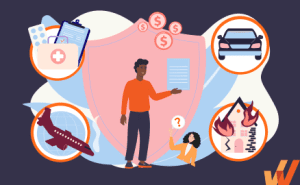Insurance providers have leveraged emerging chatbot technologies to meet customers’ rising demands. Insurance chatbots transform how insurers interact with policyholders by automating everything from lead generation to claims processing, freeing up your agents to focus on more complex issues.
But it’s not just about efficiency—insurance chatbots provide a seamless customer experience, giving policyholders 24/7 access to the information and support they need. This means faster resolution times, happier clients, and a stronger relationship with your policyholders. As the insurance transformation continues to evolve, staying ahead of the curve with digital solutions like chatbots is essential.
In this article, we’ll cover what insurance chatbots are, their benefits, real-world use cases, examples from leading companies, and the best tools to get you started. Whether you’re looking to enhance customer engagement or streamline internal processes, you’ll find practical insights to help you take the next step in your digital transformation journey.
What Is an Insurance Chatbot?
An insurance chatbot is a virtual assistant that helps insurance companies automate inbound customer communication and requests. They can handle tasks like answering common questions, processing digital claims, and providing 24/7 support. Powered by either AI or predefined rules, chatbots improve efficiency and enhance the customer experience across various insurance operations.
Rule-based vs. AI-driven insurance chatbots
Rule-based chatbots follow preset workflows, handling straightforward tasks like answering FAQs or guiding users through predefined processes. They’re ideal for simple, repetitive tasks but have limitations in handling more complex scenarios.
AI-driven chatbots, powered by advanced insurance technology, understand customer intent and engage in dynamic, human-like conversations. These bots learn from interactions, making them versatile tools for various insurance operations, including underwriting and fraud detection.
Related Resources
Benefits of Insurance Chatbots
Whether streamlining operations or enhancing CX with self-service experiences, chatbots are transforming the insurance industry by automating tasks, improving productivity, and ensuring a seamless customer experience.
Below are a few of the key benefits of implementing insurance chatbots:
- 24/7 customer support: Insurance chatbots provide round-the-clock, real-time support. Customers get immediate assistance anytime, eliminating long wait times and missed conversations.
- Simple claims processing and settlement: 44% of customers prefer using chatbots to make insurance claims. Chatbots simplify reporting incidents and help customers track their claim status effortlessly, improving overall satisfaction.
- Enhanced security and chatbot data privacy: By automating workflows, Chatbots help protect sensitive customer information. With advanced chatbot software, data is securely processed, reducing the risk of human error or data leaks and making chatbot data privacy a top priority.
- Multilingual support: Chatbots can support multiple languages, allowing insurers to engage with a diverse customer base without hiring additional multilingual support agents.
- Cost reduction: In 2022, chatbots helped businesses save over $8 billion in customer interaction costs. You can handle unlimited customer queries without expanding your workforce by automating responses.
- Improved agent productivity: 64% of agents using AI chatbots and digital assistants can focus on more complex, value-driven tasks. Chatbots manage routine inquiries, allowing your agents to solve high-priority issues.
- More engaged customers: Chatbots improve customer engagement by providing fast, efficient service without long phone queues. When integrated with CRM systems, chatbots can access detailed customer data to deliver personalized experiences, further enhancing the customer experience.
- Lead generation: Chatbots make lead generation feel effortless. Adding a simple contact form lets you gather valuable customer information before the chatbot conversation begins, turning visitors into potential leads.
Top 10 Use Cases of Insurance Chatbots
Insurance chatbots have revolutionized how insurers interact with customers and manage day-to-day operations. From policy management to fraud detection, chatbots can significantly enhance efficiency and customer experience while reducing costs.
Below are ten use cases of insurance chatbots that can help you optimize your organization’s operations, improve policyholder engagement, and drive growth:
1. Claims processing and settlement
Claims processing is one of the most stressful aspects of insurance for both the customer and the business. Chatbots can simplify this by handling the entire process from start to finish. Policyholders can report incidents, update claim details, and track their claim status—all through a chatbot.
By automating these steps, chatbots reduce wait times and alleviate the burden on your human agents, allowing them to focus on more complex claims. This means quicker resolutions, less frustration, and a more transparent claims process for policyholders, ultimately improving their customer experience.
2. Policy management
One of the most practical uses of insurance chatbots is in policy management. A chatbot can assist customers throughout the entire policy lifecycle when seamlessly integrated with your existing systems. Whether they need to apply for a new policy, update their account details, or order an insurance card, chatbots provide immediate support without involving human agents. This level of automation ensures a smoother customer experience, making it easier for policyholders to manage their insurance without lengthy back-and-forth communication.
3. Customer onboarding
The customer onboarding process for insurance policyholders is time-consuming, tedious, and requires manual data entry and verification. Insurance chatbots streamline this process by guiding new policyholders through steps like filling out forms, providing documentation, and answering questions. With chatbots, onboarding becomes faster, more efficient, and less stressful for the customer. The chatbot can also automate follow-up tasks, ensuring the customer completes all the required steps to finalize their policy without overwhelming them.
4. Risk assessment and underwriting
Insurance chatbots can assist in the risk assessment and underwriting process. Chatbots can pre-screen applications and provide underwriters with key data by gathering detailed customer information through guided conversations. This not only speeds up the underwriting process, but also ensures more accurate assessments. In some cases, AI-driven chatbots can even analyze the data and offer risk recommendations, helping insurers make informed decisions faster.
5. Payment collection
Making payments simple and convenient for customers is another important use case for insurance chatbots. By integrating with your payment systems, chatbots can remind policyholders of upcoming payments, auto-fill their details, and even process payments directly through a secure form. This automation enhances the customer experience and reduces the chance of late payments or errors. Plus, the chatbot can provide real-time support for payment-related questions, ensuring a smooth transaction every time.
6. Provide advice and information
Chatbots excel at answering FAQs, from policy details to billing inquiries. A well-integrated chatbot can tap into your knowledge base, delivering accurate answers instantly. This reduces your agents’ time on repetitive queries, freeing them up for more critical tasks.
Chatbots can also offer personalized advice based on customer profiles, making the interaction more tailored and meaningful. With chatbots managing common questions, your customer support team can focus on more complex issues that require a human touch.
7. Feedback and loyalty
Gathering customer feedback is essential for improving your insurance offerings and customer service. Chatbots can play a significant role here by automating feedback collection after critical interactions, such as after a claim is processed or a support ticket is closed.
Whether using a simple NPS survey or a more detailed questionnaire, a chatbot ensures higher response rates by making it easy for customers to provide feedback. This data can then enhance the chatbot’s performance and improve overall customer satisfaction, fostering loyalty in the long run.
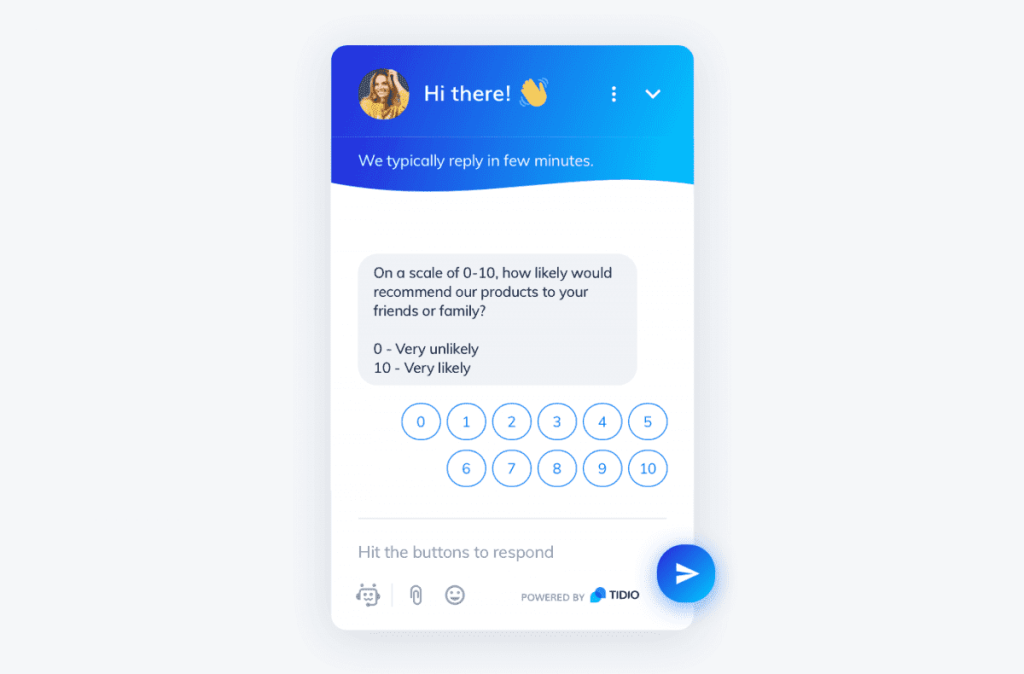
8. Cross-selling and upselling
While acquiring new customers is essential, insurance chatbots can also help you maximize revenue from your existing clients. Chatbots can analyze customer data and present tailored upsell or cross-sell opportunities based on their current policies, demographics, or claims history.
For example, a chatbot can suggest adding accident coverage to a customer’s auto policy or upgrading a health insurance plan. This strategic use of chatbots can boost sales and enhance the customer experience by providing relevant offers at the right time.
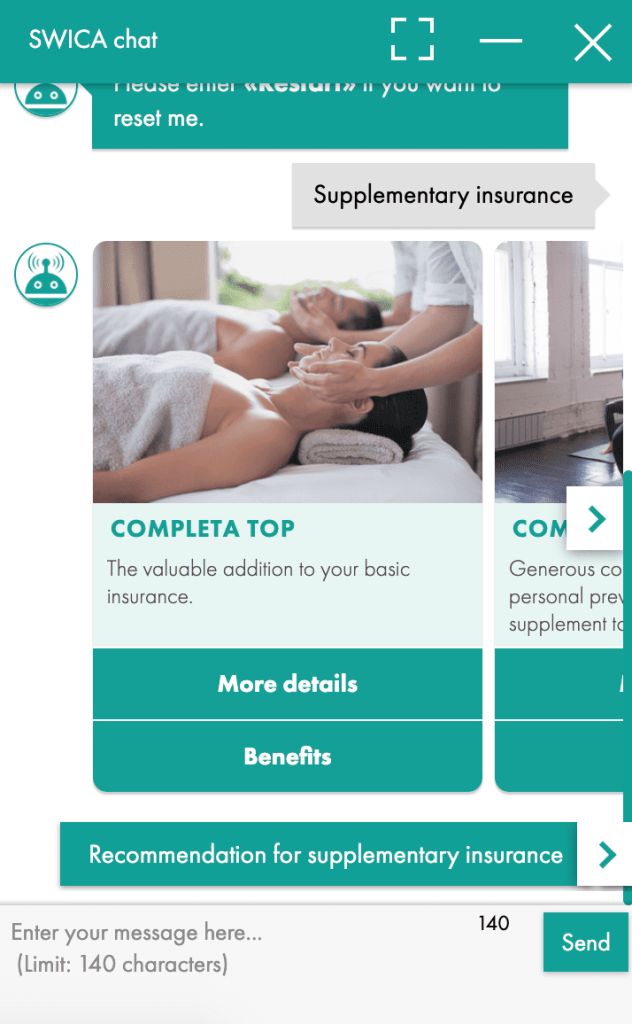
9. Advertising and promotion
Insurance chatbots are highly effective in supporting your marketing efforts. Marketing teams can use chatbots to inform customers about new offers, discounts, and promotions in real time—all while driving lead generation. Chatbots can share relevant content, like whitepapers or blog posts, and capture lead information in a non-intrusive way. This automated interaction can replace traditional forms of advertising with a more personalized, engaging experience.
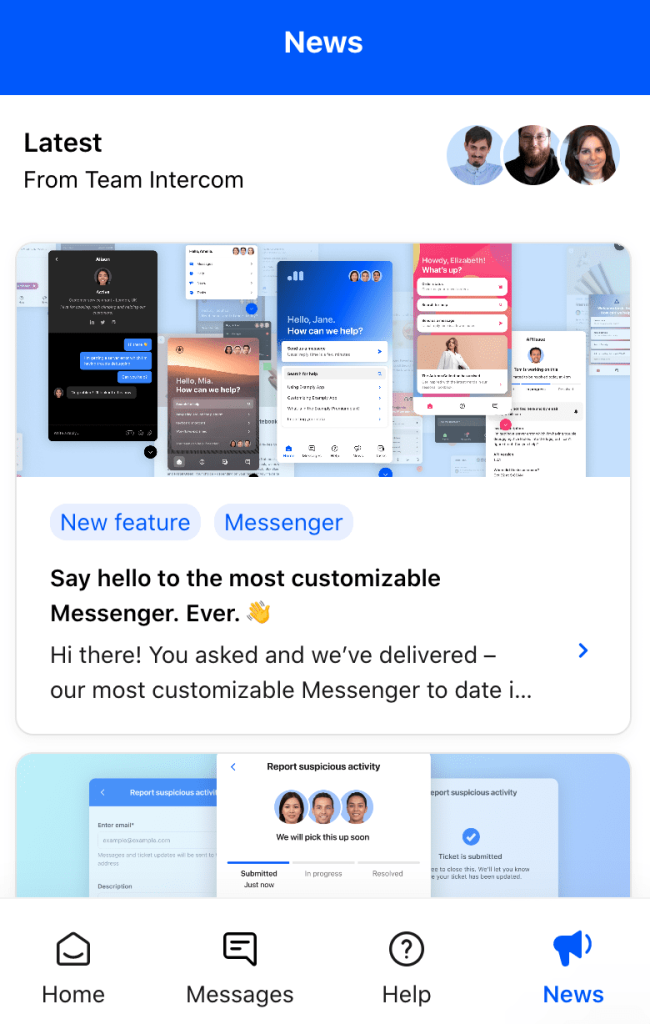
10. Fraud detection
As fraud detection becomes more advanced, insurance chatbots play a role in identifying and mitigating fraudulent activities. Powered by AI and machine learning, chatbots can flag suspicious patterns or behaviors during the claims process, alerting your team to potential fraud before it escalates.
McKinsey predicts that by 2030, AI-driven tools will be essential in detecting and preventing fraud, and insurance chatbots will be a core part of that toolkit. Integrating your chatbot with fraud detection software can improve your defenses against fraudulent claims, saving your company time and resources.
Read the case study now!
Examples of Insurance Chatbots
Insurance chatbots have quickly become integral to leading companies delivering efficient and personalized customer service. From helping policyholders manage their accounts to facilitating quick claims processing, these bots streamline operations and create smoother customer experiences.
As insurance companies increasingly turn to automation, chatbots have become critical for engaging with customers 24/7, reducing wait times, and providing tailored responses based on customer data.
Let’s explore real-world examples of insurance chatbots, demonstrating how these digital assistants transform customer service and beyond.
1. GEICO
GEICO, a well-known auto insurance provider, leverages a virtual assistant to enhance customer service. The chatbot is designed to handle basic insurance and policy questions, providing a quick way for users to get the information they need. While GEICO’s bot can start conversations and understand user intent, it currently doesn’t handle complex requests like generating a quote. Instead, it directs users to the appropriate sales page.
Despite this limitation, the chatbot is intuitive and can recognize various customer queries, offering links to helpful resources. It’s also designed to gather user feedback at the end of each interaction, allowing GEICO to improve its chatbot’s performance continuously. This focus on customer service shows how even basic chatbot implementations can deliver value by enhancing user experience and refining the support process over time.

2. SWICA
SWICA, a health insurance provider, has developed a sophisticated chatbot specifically for customer service. This bot does much more than answer FAQs—it can handle various policy-related tasks without redirecting customers to different pages. Users can update personal details, change policy options, order insurance cards, or even include accident coverage all within the chatbot interface.
By empowering users to manage their policies independently, SWICA’s chatbot offers a frictionless customer experience that reduces the need for human intervention. This chatbot functionality is a clear example of how insurance companies can leverage automation to improve efficiency and customer satisfaction while giving customers greater control over their insurance policies.

3. Sensely
Sensely is a conversational AI platform that helps healthcare and insurance companies enhance patient and customer engagement. Its chatbot is designed to guide users through various healthcare-related services, from assessing health risks to managing chronic conditions. Sensely’s chatbot doesn’t just handle insurance inquiries—it is critical in improving health outcomes by offering personalized advice based on the user’s condition and insurance plan.
Combining artificial intelligence with healthcare knowledge makes Sensely’s chatbot a valuable resource for patients and insurers. Whether helping users find the right insurance plan or providing recommendations for healthcare resources, Sensely demonstrates how chatbots can be tailored to deliver specialized services while maintaining a seamless user experience.

4. Insurify
Insurify, a popular insurance comparison website, was one of the early adopters of chatbot technology in the insurance industry. Its chatbot is designed to help users find the most suitable insurance policy by asking clarifying questions. What sets Insurify’s bot apart is its ability to process text and images. Users can upload photos like license plates to refine their insurance search further.
Powered by natural language processing and machine learning, Insurify’s chatbot offers a smooth and intuitive experience that guides users to the best insurance options based on their needs. Operating within Facebook Messenger, the chatbot provides a convenient, user-friendly platform that makes comparing insurance policies as simple as chatting with a friend.

5. Lemonade
Lemonade, an AI-powered insurance company, has taken chatbots to the next level by integrating them into every customer journey stage. From applying for policies to making payments and filing claims, Lemonade’s chatbot, Maya, is the go-to interface for policyholders looking to manage their insurance. What’s particularly impressive about Lemonade’s chatbot is its speed—Maya made world record-breaking headlines for processing and paying a claim in under 3 seconds.
Lemonade’s approach shows how AI-driven chatbots can simplify the insurance process and dramatically reduce the time it takes to resolve claims. By automating nearly every interaction a customer might need, Lemonade has created a chatbot that embodies the future of insurance—quick, efficient, and customer-centered.
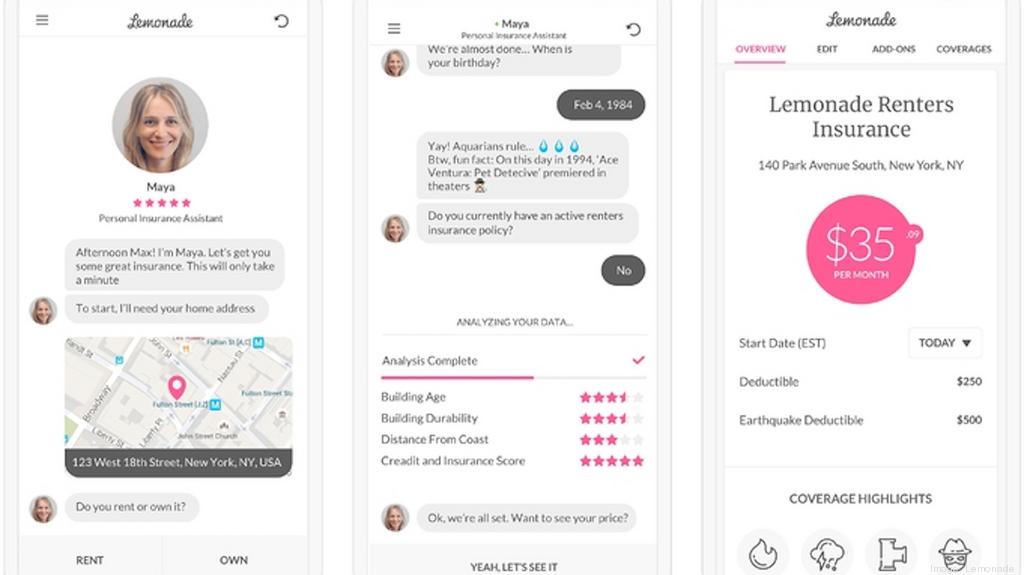
5 Best Tools for Creating Insurance Chatbots
Choosing the right chatbot platform is crucial for building a practical digital assistant to handle the insurance industry’s unique needs. Whether you want to streamline claims processing, improve customer service, or enhance policy management, the right tool can make all the difference.
Below are five leading insurance chatbot platforms to consider:
1. Haptik
- G2 Rating: 4.4 out of 5 stars
- Pricing: Contact for pricing details
Haptik is an AI-powered platform that builds omnichannel chatbots to improve customer experiences across various industries, including insurance. Its virtual assistants help insurers manage key tasks such as policy management, claims processing, and payment handling. Haptik integrates easily with websites, Facebook Messenger, Instagram Direct, SMS, and Google Business Messenger, making it a versatile tool for insurers looking to enhance customer service across multiple touchpoints.

2. SnatchBot
- G2 Rating: 4.7 out of 5 stars
- Pricing: Contact for pricing details
SnatchBot is a highly flexible chatbot platform that supports process automation and can be deployed on multiple channels. Insurers can use SnatchBot to create complex workflows, run sentiment analysis, and translate conversations into multiple languages. Its intuitive interface allows for creating highly customized chatbots without coding skills. It is a cost-effective solution for insurance companies looking to automate customer service, claims handling, and policy updates.

3. Inbenta Chatbot
- G2 Rating: 4.5 out of 5 stars
- Pricing: Contact for pricing details
Inbenta offers a conversational AI platform with a powerful chatbot to handle complex insurance operations. With the help of Robotic Process Automation (RPA), Inbenta can automate routine tasks like transactions, policy modifications, and claims tracking. Its standout feature is its zero-training implementation. You can get your chatbot up and running without a lengthy onboarding process, making it ideal for insurers seeking quick and efficient deployment.

4. Acquire
- G2 Rating: 4.2 out of 5 stars
- Pricing: Contact for pricing details
Acquire is a customer service platform that combines AI chatbots with live chat and video calling to create a seamless user experience. Insurers can use Acquire to automate customer interactions and streamline processes like claims handling, policy management, and customer inquiries. The platform’s no-code setup makes it accessible for businesses looking to quickly deploy and manage chatbot conversations without technical expertise.

5. yellow.ai
- G2 Rating: 4.4 out of 5 stars
- Pricing: Contact for pricing details
yellow.ai is an enterprise-grade conversational AI platform that enables insurers to automate complex processes and customer interactions. The platform allows for dynamic conversation journeys and can be customized to meet insurance companies’ specific needs. From claims processing to customer service automation, Yellow.ai offers a comprehensive toolkit for enhancing efficiency and improving customer engagement in the insurance sector.
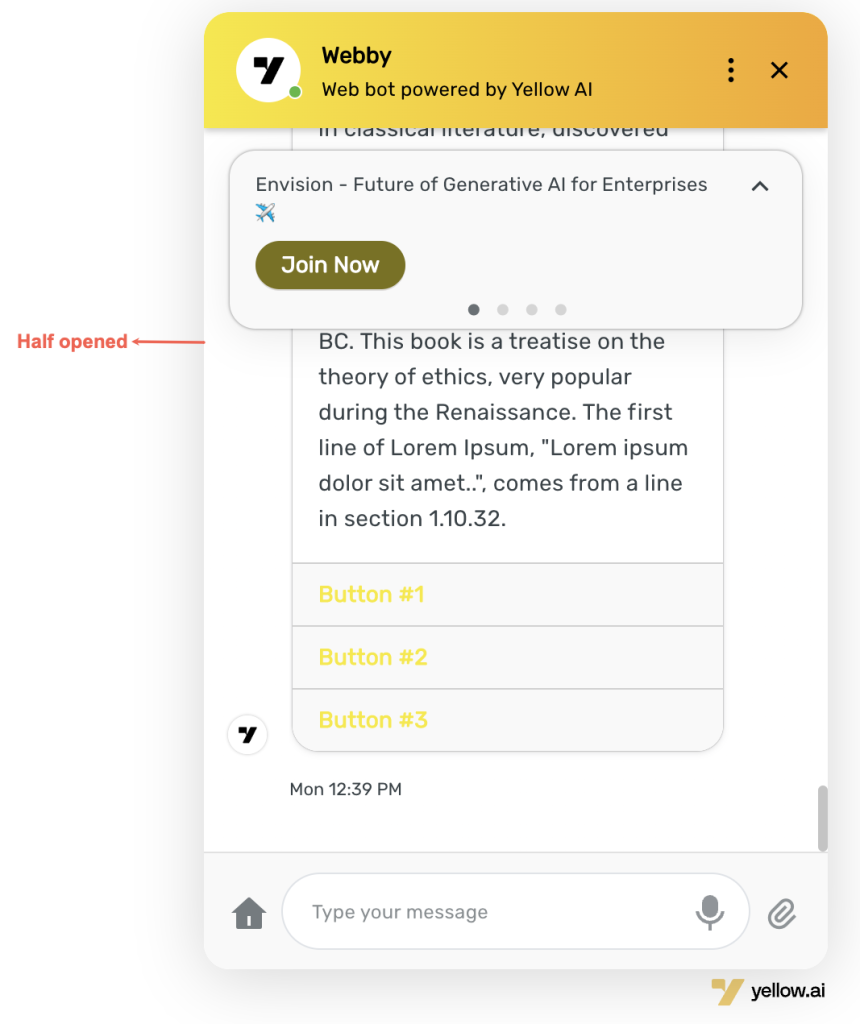
Insurance Applications Click Better With Whatfix
Insurance chatbots can revolutionize how you manage customer service, automate workflows, and streamline operations like claims processing and policy management. To fully realize the potential of this technology, it’s essential to have the right support in place to ensure both smooth implementation and optimal use.
Whatfix’s digital adoption platform (DAP) provides the tools to seamlessly integrate insurance chatbots into your business processes while empowering your team and customers to make the most of this powerful technology.
With Whatfix, your insurance company can enhance chatbot deployment through features that provide personalized guidance, boost employee productivity, and improve customer satisfaction.
Here’s how Whatfix supports your chatbot implementation:
- In-app guidance: Deliver step-by-step instructions and real-time guidance to agents and employees using the chatbot platform, enabling quick adoption of new chatbot functions.
- Just-in-time support: Provide on-demand, contextual assistance to users, making chatbot navigation simpler for both employees and customers when it matters most.
- Intelligent nudges: Use automated prompts to guide users through complex processes, ensuring they easily complete tasks like claim submissions or policy updates with minimal friction.
- Self-service support: Enable customers to resolve issues independently through self-service features within the chatbot, improving satisfaction while reducing the need for live agent support.
- Analytics and optimization: Track how employees and customers interact with your chatbot and leverage insights to continually optimize workflows, improving efficiency and performance.
By integrating Whatfix into your chatbot strategy, you can streamline both the customer and employee experience. With personalized, real-time support and enhanced user adoption, Whatfix helps you unlock the full potential of digital transformation within the insurance industry.
Learn more about embracing digital transformation for your insurance business today!

